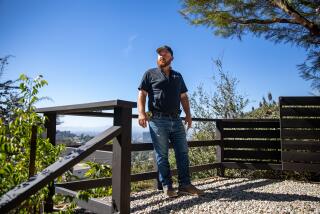Archeologists Wonder: ‘Roots’ or a Root Cellar?
- Share via
WESTON, Conn. — Up a steep, narrow road in a remote part of this small town is an old icehouse with only the four stone walls still standing. A tunnel runs from the icehouse more than 20 feet and stops, but the mystery surrounding it has lingered for generations.
Legend has it that the property was a stop on the Underground Railroad, and a team of archeological experts from Central Connecticut State University spent several days in August digging at the site for clues.
Experts do not expect to know for months whether the property was a stop for slaves because they must sift through artifacts found in the dirt and walls, and conduct more research of the area. But their findings, which include ceramics stuffed in the wall, a bone-handled knife, nails and animal bones, intrigued them.
“It’s just curious why we’re finding these household goods in the tunnel,” said Jerry Sawyer, an adjunct instructor at the university. “Certainly it has that potential. But we cannot say definitively that it is.”
Warren Perry, an anthropology professor at the university who specializes in the African diaspora, said some of the artifacts were found near the doorway. Such items might have been used to bless the house as part of an African spiritual practice known as minkisi, he said.
“They would do it in the doorways because that’s where the spirits pass through,” Perry said. “Each of these items by themselves are significant for African spiritual practices, especially when they’re associated together. And they’re right where they should be, by the doorway.”
The project is the latest in a growing national effort to document sites on the secret informal network of safe houses used by fugitive slaves in their quest for freedom in the 1800s. The National Underground Railroad Freedom Center, a $110-million museum that opened in Cincinnati last year, hosts programs and forums on slavery and the resistance movements.
“It is something that has been growing in intensity over the past decade,” said Robert Forbes, associate director of the Gilder Lehrman Center for the Study of Slavery, Resistance and Abolition at Yale University. “Every new confirmed site gives us new data that expands our understanding of what remains really a very shadowy chapter in American history.”
Forbes urged caution, saying that some suspected sites may be no more than folklore and romance. “There are a lot of root cellars and basements and cupboards that have been imaginatively converted into hiding places,” Forbes said.
He said he would like to see letters or other documents tying the property owner to the antislavery movement.
Nationwide, there are potentially thousands of stops on the Underground Railroad, said Diane Miller, national coordinator of the Network to Freedom Program of the National Park Service. But there is academic resistance to the effort to identify sites, with some dismissing the accounts of Underground Railroad sites as mostly mythology, despite oral traditions that can provide clues that lead to descendants and documentary evidence, Miller said.
“We would love to see these sites nominated to the Network to Freedom,” Miller said.
Weston, a wealthy mostly white town in Fairfield County with a population of about 10,000, was divided over slavery in the 19th century, local historians said. The town was not known as a center for abolitionists, like Auburn, N.Y., where former slave Harriet Tubman -- who became a scout, nurse and spy during the Civil War -- helped more than 300 runaway slaves finish their flight. But the icehouse on Ladder Hill Road is less than a mile from Little Egypt, a 19th century colony of black residents.
No one is sure where the legend came from, but many residents have heard it for decades.
“It really is the lore on Ladder Hill Road since before my time,” said Mary Ann Barr, a Weston historian who has lived on the street since the 1950s. She heard the account from families who lived on the street since the 1920s.
Barr is researching other icehouses and root cellars, but so far none has tunnels. She also is looking into the Bulkley family, who owned the property, but all she knows is that they were farmers.
Ellen Strauss, an attorney who owns the property and requested the excavation, hopes to have the site designated a historic landmark if it is a confirmed stop on the Underground Railroad. Strauss noted that the tunnel heads toward an adjacent house with a black chimney, the traditional mark of British Tories who were willing to free slaves if they fought for the Crown.
“When I was a kid we used to crawl in there,” Strauss said. “I’m very excited about it. I have every expectation that they’re going to find evidence to prove the oral history we’ve all heard over the years.”
College students recently spent a week crawling around the dirt with trowels, brushes and other tools. Sawyer, who tells his students that “the truth is in the ground,” was intrigued by pieces of pottery that were shoved into the icehouse wall.
“That’s not a smoking gun, but it’s a curiosity,” he said. “People that passed through Underground Railroad sites often [left] a mark to let someone know they were there.”
More to Read
Sign up for Essential California
The most important California stories and recommendations in your inbox every morning.
You may occasionally receive promotional content from the Los Angeles Times.













